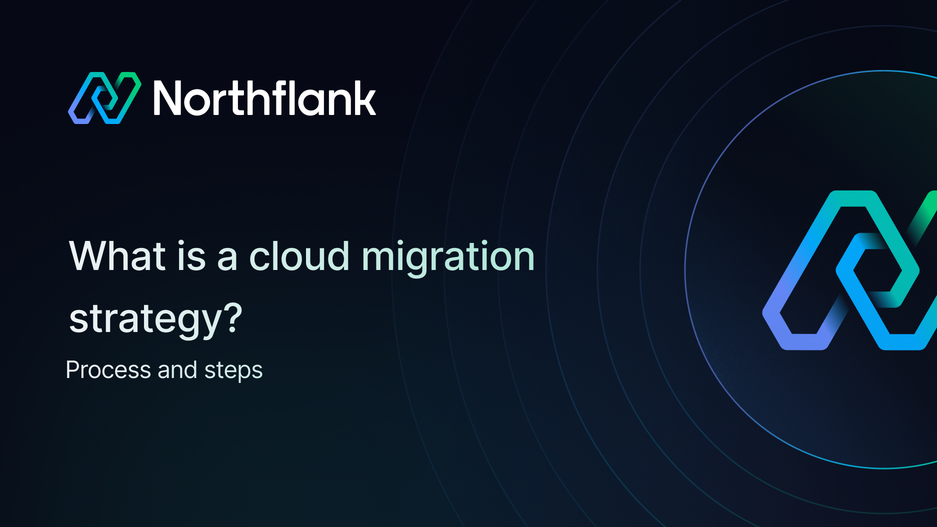

What is a cloud migration strategy? Process and steps
A cloud migration strategy is a comprehensive plan that outlines how your organization will move applications, data, and infrastructure from on-premises systems or other environments to the cloud. It defines which migration approach you'll use, what resources you'll need, and how you'll minimize risks and downtime during the transition. Without a clear strategy, cloud migrations often face cost overruns, security vulnerabilities, and extended timelines.
A cloud migration strategy is your roadmap for successfully transitioning to the cloud. It encompasses everything from assessing your current infrastructure to selecting the right migration approach and managing the post-migration environment.
Your strategy should answer key questions: Which workloads will you migrate first? Will you rehost applications as-is or refactor them to leverage cloud-native features? How will you handle data security during the transition? What's your rollback plan if something goes wrong?
It's like your blueprint for transition. A clear strategy helps you avoid common pitfalls like unexpected costs, application downtime, and compatibility issues. It also ensures your team knows exactly what to do at each stage of the migration.
Moving to the cloud without a strategy is like sailing without a map; you might eventually reach your destination, but the journey will be chaotic and expensive.
This is what happens when you plan properly: you minimize business disruption, control costs, and ensure your applications perform better in the cloud than they did on-premises. You also reduce security risks by identifying vulnerabilities before they become problems.
A well-defined strategy helps you prioritize workloads based on business value and complexity. Maybe your customer-facing applications need to migrate first to improve scalability, while legacy systems can wait. This prioritization prevents you from overwhelming your team and budget.
At Northflank, we've seen organizations cut their migration timelines in half simply by having a clear strategy in place. The platform helps you deploy and manage cloud infrastructure efficiently, from migrating a single application to your entire tech stack.
Get started with Northflank for free or book a demo with our expert engineers to discuss your specific use case and migration challenges.
The 6 R's framework gives you six distinct approaches to migrating your applications. Each "R" represents a different strategy, and you'll likely use multiple approaches across your migration project.
Rehosting means moving your applications to the cloud without making any changes. You're essentially lifting them from your current environment and shifting them to cloud infrastructure.
This approach is the fastest and least complex. It's ideal when you need to migrate quickly or when your applications already work well and don't need cloud-specific optimizations. However, you won't immediately benefit from cloud-native features like auto-scaling or serverless computing.
With replatforming, you make minor optimizations during migration without changing your application's core architecture. You might switch to a managed database service or containerize your application for better portability.
This approach gives you some cloud benefits without the complexity of a full redesign. It's a middle ground that works well when you want to improve performance or reduce operational overhead without a complete overhaul. If you're looking to migrate from on-premise to cloud, replatforming often provides the best balance of effort and benefit.
Refactoring involves redesigning your applications to take full advantage of cloud-native features. You might break down a monolithic application into microservices or adopt serverless architectures.
This approach requires the most effort and technical expertise, but it delivers the greatest long-term benefits. You'll get better scalability, performance, and cost efficiency. Consider refactoring for your most critical applications where cloud-native capabilities will provide significant competitive advantages.
Repurchasing means replacing your existing application with a cloud-based alternative, typically a SaaS solution. Instead of migrating your on-premises CRM, for example, you might switch to Salesforce.
This approach reduces maintenance overhead and gives you immediate access to modern features. However, you'll need to manage data migration and ensure the new solution meets your requirements. It's particularly effective for commodity applications where custom solutions don't provide competitive advantage.
Not everything needs to migrate. Some applications have outlived their usefulness or have been replaced by newer systems. Retiring these applications reduces complexity and cuts costs.
Use your migration project as an opportunity to audit your entire application portfolio. You might discover that 20% of your applications are rarely used or provide duplicate functionality. Removing these cuts down what you need to maintain going forward.
Some applications should stay where they are, at least for now. Maybe they have compliance requirements that make cloud migration complex, or perhaps they're scheduled for replacement soon.
Retaining doesn't mean never migrating, it means waiting until the timing is right. You might revisit these applications after your primary migration is complete or when regulatory requirements change. This approach prevents your migration from stalling on edge cases.
Creating your migration strategy doesn't have to be complicated. Follow these steps to build a plan that works for your organization.
- Start with a comprehensive assessment: Document every application, database, and dependency in your current environment. Understand what you have before deciding what to migrate. This assessment reveals hidden dependencies that could cause problems later.
- Define your business objectives: Are you migrating to reduce costs, improve scalability, or enhance disaster recovery? Your objectives will guide every decision you make. If cost reduction is your priority, you'll favor different approaches than if you're optimizing for performance.
- Choose your cloud provider: Different providers specialize in different areas. If you're considering AWS, Azure, or Google Cloud, evaluate them based on your specific requirements. You might even adopt a multi-cloud or hybrid cloud approach for different workloads.
- Prioritize your workloads: Not everything should migrate at once. Start with low-risk applications that deliver quick wins. This builds momentum and helps your team gain cloud expertise before tackling complex migrations.
- Select your migration approach: Use the 6 R's framework to determine the right approach for each application. Your strategy will likely combine multiple approaches based on each application's requirements and business value.
- Plan for security and compliance: Identify data residency requirements, encryption needs, and compliance obligations before you migrate. Address these upfront rather than discovering them mid-migration when they're harder and more expensive to fix.
- Prepare your team: Cloud migration requires new skills and processes. Invest in training and consider bringing in expertise for specialized areas. Your team's readiness is just as important as your technical plan.
Northflank simplifies many of these steps by providing a unified platform for deploying and managing your cloud infrastructure. You can migrate applications gradually, test them in cloud environments, and manage both legacy and cloud-native workloads from a single interface.
Get started with Northflank for free or book a demo with our expert engineers to discuss your specific use case and migration challenges.
Even with a well-planned strategy, you'll face challenges during migration. Understanding them helps you prepare.
Cost overruns happen when you don't optimize cloud resources properly. Without proper planning, you might over-provision resources or leave unused instances running. Monitor your spending closely and right-size your resources based on actual usage patterns.
Application dependencies often surprise teams during migration. An application you thought was standalone might depend on services, databases, or network configurations you didn't know about. Your assessment phase should map all dependencies, but be prepared for discoveries during migration.
Performance issues can emerge after migration if you don't optimize for cloud architectures. An application that performed well on-premises might struggle in the cloud if it wasn't designed for distributed environments. Test thoroughly before cutting over production traffic.
Security gaps appear when you don't properly configure cloud security controls. The shared responsibility model means you're responsible for securing your applications and data even though the cloud provider secures the underlying infrastructure. Don't assume default configurations are secure enough for your needs.
Skills gaps slow migrations when your team lacks cloud expertise. Cloud platforms work differently from traditional data centers. Budget for training or consider working with partners who can accelerate your migration.
If you're dealing with a complex environment, like migrating from Heroku, you'll want a platform that handles the complexity for you while giving you control over the migration process.
Your cloud migration strategy is the foundation for a successful transition. Take the time to plan thoroughly, involve stakeholders from across your organization, and remain flexible as you learn what works for your specific environment.
Remember that cloud migration isn't a one-time project, it's the beginning of your cloud journey. Your strategy should adapt as your organization grows and as cloud technologies advance.
To start your migration, Northflank provides the tools and infrastructure you need to migrate confidently.
If you're moving from on-premises systems, migrating between cloud providers, or even considering migrating from cloud to on-premise, our platform adapts to your needs and helps you manage complex migrations with less risk and overhead.
Get started with Northflank for free or book a demo with our expert engineers to discuss your specific use case and migration challenges.